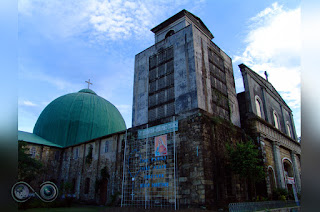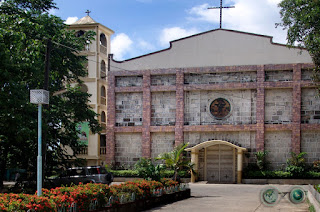Here are the Pangasinan Catholic churches, the ones i've visited anyway.

-Manaoag: Basilica of Our Lady of Manaoag
-Alaminos City: St. Joseph Parish
-Bolinao: St. James the Great Parish
-Mabini: Sto. Niño Parish
-Agno: St. Catherine of Alexandria Parish
-Binmaley: Our Lady of Purification Parish
-Lingayen: Epiphany of our Lord Parish
-Mangatarem: St. Raymond of Peñafort
-Aguilar: St. Joseph the Patriarch Parish
-Bugallon: Our Lady of Lourdes Parish
-Burgos: St. Isidore Parish
-San Manuel: St. Bartholomew Parish
-San Fabian: St. Fabian, Pope, and Martyr
-Calasiao: Sts. Peter and Paul Parish
-San Carlos City: St. Dominic de Guzman
-Malasiqui: St. Ildephonse Parish
-Bayambang: St. Vincent Ferrer Parish
_______________________________________
MANAOAG
Basilica of Our Lady of Manaoag
MANAOAG
Basilica of Our Lady of Manaoag



History:
1601 – the Parish was established.
1701 – the first church was built.
1892 – the church was destroyed by an earthquake and then later rebuilt.
1898 – burned by the revolutionaries, the image was found abandoned at the back of the church.
1912 – the church was completely reconstructed to its present form.
2011 – the church was canonically approved.
Facts:
-Granted “Special Bond of Spiritual Affinity in Perpetuity” - equal to that when visiting a papal basilica in Rome. The first to receive.
-The image is fully secured with bulletproof glass enclosure.
- Miraculous image of the Virgen Mary.
_______________________________________
ALAMINOS CITY
St. Joseph Cathedral


History:
1766 – Parish was founded.
1770 – the first chapel was constructed.
1814 – the chapel and the convent were burned.
1837 – it was constructed with more durable materials, stone.
1879 – the nipa roof was changed and a wooden flooring was installed.
1926 – bell tower was improved, fitted w/ three bells and roofed with galvanized iron.
Facts & Features:
In 1849, Father Tornos administered the church for 30 years and endowed the church with the best ornaments. He died in 1878 and was buried in the cathedral. At the church pavement, one can view his tombstone in Spanish. This church is constructed with bricks, manufactured locally. The edifices are the tallest and most spacious in the province.
_______________________________________
BOLINAO
St. James the Great Parish Church



History:
As early as the 1500s, missionaries set foot in Bolinao. Their work ended in 1607.
1609 – Parish was established and a church was built.
1788 – half of the bell tower was toppled by an earthquake and then later repaired.
1819 – the church convent was accidentally burned.
2009 – the church was heavily damaged by typhoon Emong.
Facts and Features:
This church is made of black coral stones. The bell tower was once the tallest in the entire island of Luzon. It served as a fortress against the pirates on several occasions.
_______________________________________
MABINI
Sto. Niño Church

History:
1830 – the church was first built.
1832 – a great flood struck the town.
1852 – the church was struck by lightning and was burned down.
1881 – a second great flood devastated the town.
1999 – it was torn down by a strong earthquake.
2005 – the church was fully restored.
_______________________________________
AGNO
St. Catherine of Alexandria Church


History:
1620 – Parish was founded.
1835 – started the church construction.
1842 – the bell tower was built.
1887 – the church was completed.
_______________________________________
BINMALEY
Our Lady of the Purification Church


Albino bats reside in the church.

History:
1672 – Parish was established.
1674 – the church was first built.
1754 – the church was completely constructed.
1945 – the church was destroyed by the war.
Facts & Features:
The church is Baroque in architecture. The bell is one of the three biggest bells in the Philippines, cast in 1804 weighing 4,130 pounds.
_______________________________________
LINGAYEN
The Epiphany of our Lord ParishChurch

History:
1575 – Parish was established by Augustinians.
1616 – the town first received a pastor.
1862 – its famous dome was built.
1945 – the church and the convent was bombed during the war.
_______________________________________
MANGATAREM
St. Raymond of Peñafort Church




History:
1827 – Parish was established.
1835 – a church was first built.
1851 – started the construction of the bell tower.
1862 – the church was burned down and was reconstructed in 1875.
1886 – the church convent was rebuilt.
1990 – the church was damaged by a strong earthquake.
Facts & Features:
An early Renaissance facade with a low pediment. Its upper and lower levels are divided by dentil-like elements.
_______________________________________
AGUILAR
St. Joseph the Patriarch Church



History:
1810 – Parish was founded.
1846 – the church was rebuilt with a more enduring concrete
1859 – the ceiling was replaced with logs and was completed in 1867.
1866 – a bell was placed.
1874 – the hight altar was constructed.
1875 – church tower was completed.
1877 – another bell was installed while the old one was repaired.
1879 – the church roof was changed from nipa to galvanized iron.
1945 – the church escaped war destructions when a bomb failed to explode.
_______________________________________
BUGALLON
Our Lady of Lourdes Church




History:
1714 – Parish of Our Lady of Lourdes Church founded.
1733 – the church was built.
1953 – floods annihilated the church, transferring all objects to the new church.
2012 – the church became a home of flood victims.
A constant massive flooding caused the town center of Bugallon to be transferred, but the Our Lady of Lourdes Church, could not be transferred (because every time someone attempts, he dies according to folklore). A new church was created in the newly established town center, the Saint Andrew Church. This is the reason why Bugallon has two churches.
_______________________________________
BURGOS
St. Isidore Parish Church

History:
1876 – Parish was created and a church was built.
Facts:
The founding missionaries built the present façade of the church, made mostly of quarried adobe stones.
_______________________________________
SAN MANUEL
St. Bartholomew Parish Church

History:
1688 – Parish was founded.
1720 – a chapel was built but was burned down by the people due to superstition.
1882 – built the first chapel or ermita with a cruciform in its present location.
1894 – a great whirlwind destroyed the ermita which was rebuilt there after.
1898 – the church was destroyed by the revolutionaries and then later rebuilt.
_______________________________________
SAN FABIAN
St. Fabian, Pope, and Martyr Church

History:
1718 – Parish was established.
1768 – the church was built using bricks, including the altar and the belfry.
1856 – the church was destroyed by fire then later rebuilt in cruciform.
1945 – it was destroyed by the war and then later rebuilt.
2003 – the bell tower was finally restored.
_______________________________________
CALASIAO
Sts. Peter and Paul Parish Church

History:
1588 – Parish was established as St. Dominic.
1621 – Parish was replaced with Sts. Peter and Paul.
1763 – the church was burned by rebels.
1841 – it was destroyed by a typhoon and then rebuilt.
1853 – the church was destroyed by fire and then rebuilt.
1892 – it was damaged by earthquake and then restored.
1894 – the church was turned into animal pasture ground.
1945 – the church miraculously escaped 3 bombs that failed to explode.
1990 – an earthquake destroyed its belfry.
At present, the belfry has fully automatic bell/chime (tackiness of new technology).
Facts & Features:
- A baroque church.
- Declared a National Cultural Treasure by the National Museum of the Philippines and the National Commission for Culture and the Arts
_______________________________________
SAN CARLOS CITY
St. Dominic de Guzman Parish Church


History:
1588 – Parish first established.
1770 – the church was constructed with bricks and tiles of ‘apalit’.
1754 – it was transferred to what is now its present location.
1799 – it was destroyed by a massive earthquake.
1878 – its belfry was erected.
_______________________________________
MALASIQUI
St. Ildephonse Parish Church

History:
1677 – Parish was established.
1746 – the church was constructed.
1763 – it was destroyed by fire and later rebuilt and completed in 1790.
1820 – the entire town was burned down including the church then rebuilt 3 years later.
1880 – the church was annihilated by an earthquake and then it was rebuilt.
1892 – another earthquake destroyed it again and then repaired.
1990 – again, an earthquake damaged it badly.
2002 – completely reconstructed from that earthquake.
_______________________________________
BAYAMBANG
St. Vincent Ferrer Parish Church


History:
1614 – Parish was established.
1804 – the church was built using wood, then later rebuilt with bricks with a cruciform.
1856 – the church was burned and then reconstructed.
1863 – badly damaged by an earthquake.
1945 – façade was damaged by the war then later repaired.
1990 – another earthquake damaged the church.
Facts & Features:
- has 2-level Renaissance façade.
- main entrance is held by paired ionic columns.


